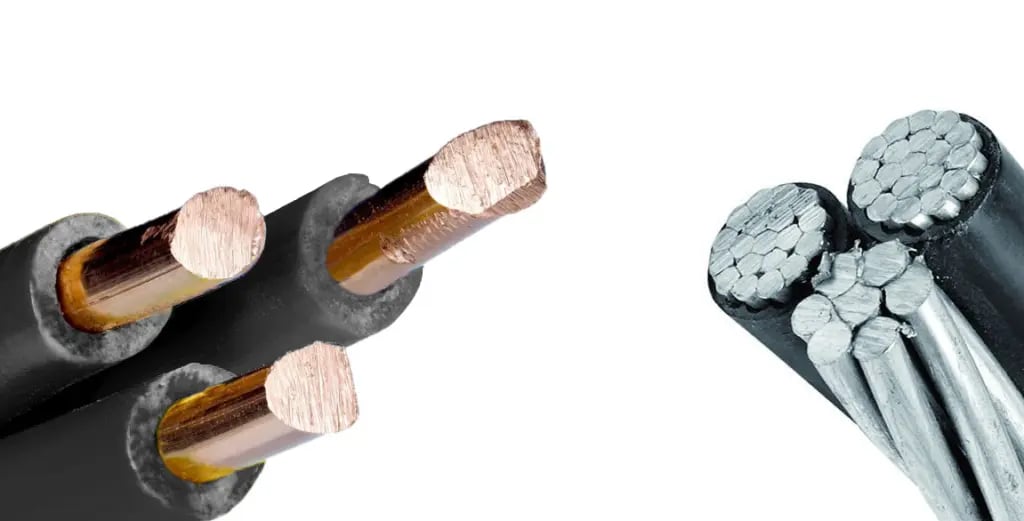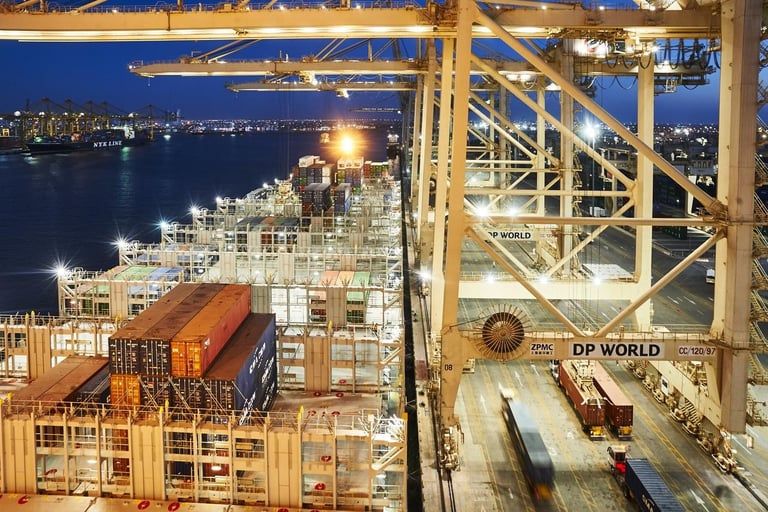📞+86 153 7530 2641 📧 hongjing.Wang@feichuncables.com
What is the Difference Between Copper Conductor Cables and Aluminum Conductor Cables in Power Cables? What Are Their Respective Application Scenarios?
Discover the key differences between copper and aluminum conductor cables. Learn which type is best suited for industrial, infrastructure, or cost-sensitive applications through performance comparisons and practical insights.
hongjing.Wang@Feichun
7/8/202514 min read


Introduction
Power cables represent the arteries of modern civilisation, carrying electrical energy to virtually every aspect of our daily lives. From the towering cranes that load cargo ships at bustling ports to the high-speed rail networks that connect cities, from the gleaming data centres that power our digital world to the solar farms that harness renewable energy, power cables are fundamental to contemporary infrastructure. The conductor material at the heart of these cables – whether copper or aluminium – plays a crucial role in determining their performance, cost, and suitability for specific applications.
The history of electrical conductors is intrinsically linked to the development of the electrical age itself. Copper emerged as the preferred conductor material during the early days of electrical power distribution due to its excellent conductivity and corrosion resistance. However, as electrical systems expanded and cost considerations became increasingly important, aluminium emerged as a compelling alternative. The post-World War II era saw significant developments in aluminium conductor technology, particularly in overhead transmission lines where weight considerations were paramount.
Today, both copper and aluminium conductors dominate the power cable market, each serving distinct niches based on their unique properties and economic considerations. The choice between these materials is not merely a matter of performance versus cost – it involves a complex analysis of electrical characteristics, mechanical properties, environmental factors, installation requirements, and long-term maintenance considerations.
Understanding the fundamental differences between copper and aluminium conductors has become essential for engineers, project managers, and procurement specialists across industries. Whether designing a port facility's power distribution system, planning a renewable energy installation, or specifying cables for a high-rise building, the conductor material choice can significantly impact both initial costs and long-term performance. This comprehensive analysis explores the technical, economic, and practical considerations that guide this critical decision.
The question of "copper or aluminium" extends beyond simple material properties to encompass broader considerations of sustainability, resource availability, and technological advancement. As global infrastructure continues to expand and modernise, making informed decisions about conductor materials becomes increasingly important for project success and long-term sustainability.
Comparison of Basic Material Properties of Copper Conductors and Aluminum Conductors
The fundamental differences between copper and aluminium as conductor materials stem from their distinct atomic structures and resulting physical properties. These differences create a complex trade-off matrix that influences every aspect of cable design and application.
Electrical Conductivity Analysis:
Copper's superior electrical conductivity stands as perhaps its most significant advantage. With a conductivity approximately 1.6 times that of aluminium, copper conductors can carry the same current with a smaller cross-sectional area. This property translates directly to more compact cable designs and improved space utilisation in installations where real estate is at a premium.
The conductivity difference becomes particularly significant in high-current applications. For instance, in a port crane system requiring 1000 amperes of current, a copper conductor might require a 400 mm² cross-sectional area, while an equivalent aluminium conductor would need approximately 630 mm². This difference affects not only the cable size but also the associated conduit systems, cable trays, and installation hardware.
Density and Weight Considerations:
Aluminium's lower density – approximately one-third that of copper – creates compelling advantages in weight-sensitive applications. This property becomes crucial in overhead installations, mobile equipment, and applications where installation labour costs are significant. The weight difference is particularly pronounced in large conductor sizes, where aluminium cables can be substantially easier to handle and install.
However, the relationship between density and conductor size creates interesting dynamics. While aluminium conductors require larger cross-sectional areas to achieve equivalent current-carrying capacity, the lower density means that the weight penalty is often less than the size increase might suggest. In many applications, aluminium cables can actually be lighter than copper equivalents despite their larger size.
Mechanical Strength and Durability:
Copper's superior mechanical properties include higher tensile strength and better resistance to fatigue and stress corrosion cracking. These characteristics make copper conductors more suitable for applications involving vibration, mechanical stress, or frequent handling. The material's ductility also allows for better formability and reduced risk of conductor breakage during installation.
Aluminium conductors, while mechanically adequate for many applications, require more careful handling during installation and are more susceptible to damage from over-tightening or mechanical stress. The material's tendency to creep under sustained load can lead to connection loosening over time, requiring specific installation techniques and maintenance procedures.
Thermal Properties and Expansion:
Both materials exhibit thermal expansion, but their expansion coefficients and thermal conductivity differ significantly. Copper's higher thermal conductivity provides better heat dissipation, which can be advantageous in high-current applications or installations with limited cooling. However, aluminium's lower thermal mass can result in faster thermal response in some applications.
The thermal expansion characteristics affect joint design and long-term connection reliability. Copper's more stable thermal expansion behaviour contributes to better long-term joint performance, while aluminium's different expansion characteristics require specific joint designs and installation procedures.
Corrosion Resistance and Environmental Stability:
Copper's natural corrosion resistance provides advantages in harsh environments, particularly those involving moisture, chemicals, or marine conditions. The formation of protective copper oxide layers helps prevent further corrosion, contributing to long-term reliability.
Aluminium's tendency to form aluminium oxide presents both advantages and challenges. While the oxide layer provides some protection against further corrosion, it also creates electrical resistance at connections, requiring special installation procedures and materials to ensure reliable joints.
Advantages and Typical Applications of Copper Conductor Cables
Copper conductor cables have established themselves as the premium choice for applications where performance, reliability, and long-term stability are paramount. Their superior electrical and mechanical properties make them indispensable in critical applications across various industries.
Performance Advantages:
The low electrical resistance of copper conductors translates directly to reduced power losses and improved system efficiency. In large industrial installations, these efficiency gains can result in significant energy savings over the cable's operational lifetime. The improved current-carrying capacity per unit cross-sectional area allows for more compact installations and reduced infrastructure requirements.
Copper's excellent oxidation resistance ensures stable electrical connections over extended periods. This stability is particularly important in applications where connection reliability is critical, such as emergency power systems, critical infrastructure, and safety-related applications. The material's resistance to corrosion in marine environments makes it the preferred choice for offshore installations and coastal facilities.
The superior joint performance of copper conductors stems from their resistance to oxidation and their mechanical stability. Copper connections maintain their electrical properties over time, reducing the need for maintenance and improving system reliability. This characteristic is particularly valuable in applications where access for maintenance is difficult or costly.
Critical Application Scenarios:
Port lifting equipment represents one of the most demanding applications for power cables. The combination of high current requirements, mechanical stress, vibration, and corrosive marine environment makes copper conductors the logical choice. Major ports worldwide rely on copper conductor cables for their ship-to-shore cranes, where reliability is essential for maintaining port operations and preventing costly delays.
High-speed rail power supply systems demand the ultimate in conductor performance. The combination of high current requirements, electromagnetic compatibility considerations, and safety requirements make copper conductors essential. The superior conductivity ensures efficient power transmission, while the mechanical stability withstands the vibrations and thermal cycling associated with high-speed rail operations.
Data centres represent another critical application where copper conductors excel. The combination of high current density, 24/7 operation, and critical reliability requirements makes copper the preferred choice. The superior heat dissipation characteristics of copper help maintain optimal operating temperatures in these demanding environments.
High-rise building trunk power supply systems benefit from copper's compact size and reliability. The space constraints in vertical installations make copper's higher current density advantageous, while the long-term reliability reduces maintenance requirements in difficult-to-access locations.
Marine engineering applications, including offshore platforms, underwater cables, and shipboard systems, rely heavily on copper conductors. The combination of corrosion resistance, mechanical strength, and electrical performance makes copper essential for these challenging environments.
Specialised Industrial Applications:
Mining equipment operates in some of the most challenging environments, where cable reliability can be a matter of safety. Copper conductors provide the mechanical strength and electrical reliability necessary for these applications. The resistance to environmental factors and the ability to withstand mechanical stress make copper cables essential for mining operations.
Chemical processing facilities require cables that can withstand aggressive chemical environments while maintaining electrical performance. Copper's corrosion resistance and stable electrical properties make it suitable for these demanding applications.
Renewable energy installations, particularly offshore wind farms, rely on copper conductors for their submarine cables and critical power transmission systems. The combination of electrical performance and environmental resistance makes copper essential for these applications.








Advantages and Typical Applications of Aluminum Conductor Cables
Aluminum conductor cables have carved out significant market segments where their unique combination of properties provides optimal solutions. While not suitable for every application, aluminum conductors offer compelling advantages in specific scenarios where weight, cost, or installation considerations are paramount.
Economic and Practical Advantages:
The most significant advantage of aluminum conductors lies in their cost-effectiveness. The raw material cost of aluminum is substantially lower than copper, making aluminum cables attractive for large-scale installations where material costs represent a significant portion of the total project budget. This cost advantage becomes even more pronounced in large conductor sizes, where the material cost difference can be substantial.
The lightweight nature of aluminum conductors provides significant installation advantages. In overhead applications, the reduced weight translates to lower structural requirements for supporting towers and poles. This weight reduction can result in substantial savings in both material and installation costs, particularly in large transmission projects.
The installation convenience of aluminum cables extends beyond weight considerations. The reduced physical stress on installation crews and equipment can improve safety and reduce installation time. In applications where cables must be pulled through conduits or installed in elevated positions, the weight advantage becomes particularly valuable.
Primary Application Domains:
Transmission lines represent the largest application area for aluminum conductors. The combination of cost-effectiveness, weight advantages, and adequate electrical performance makes aluminum the preferred choice for overhead power transmission. Major transmission networks worldwide rely extensively on aluminum conductor cables, often in configurations such as ACSR (Aluminum Conductor Steel Reinforced) that combine aluminum's conductivity with steel's mechanical strength.
Solar power installations have embraced aluminum conductors for their DC collection systems and inverter connections. The cost advantages of aluminum align well with the economic requirements of renewable energy projects, while the adequate electrical performance meets the system requirements. The outdoor installation environment suits aluminum's properties, and the cost savings can improve project economics.
Wind power systems similarly benefit from aluminum conductors in their power collection and transmission systems. The weight advantages are particularly valuable in wind turbine applications, where every kilogram of weight in the nacelle affects the structural requirements and installation costs.
Outdoor lighting systems, including street lighting and area lighting, commonly employ aluminum conductors. The cost advantages and adequate performance characteristics make aluminum suitable for these applications, where the lower current requirements don't fully utilise copper's superior conductivity.
Power infrastructure wiring, including substation wiring and distribution systems, often employs aluminum conductors where cost considerations are significant. The adequate electrical performance and cost advantages make aluminum suitable for many utility applications.
Specialised Aluminum Applications:
Industrial heating systems, where large conductors are required for high-current applications, often employ aluminum conductors. The cost advantages of aluminum become significant in these applications, while the adequate electrical performance meets the system requirements.
Temporary power installations, including construction sites and event installations, benefit from aluminum's weight advantages and cost-effectiveness. The reduced weight simplifies installation and removal, while the cost advantages are important for temporary applications.
Building distribution systems, particularly in cost-sensitive applications, may employ aluminum conductors for branch circuits and distribution feeders. Proper installation techniques and materials can ensure reliable performance while achieving cost savings.
Installation and Safety Precautions Comparison
The installation of copper and aluminum conductor cables requires different approaches, techniques, and precautions due to their distinct material properties. Understanding these differences is crucial for ensuring reliable, safe, and long-lasting electrical installations.
Aluminum Conductor Installation Considerations:
Aluminum conductors require special attention during installation due to their tendency to oxidize and form aluminum oxide at connection points. This oxide layer, while providing some corrosion protection, creates electrical resistance that can lead to heating and connection failure if not properly addressed. Installation procedures must include thorough cleaning of connection surfaces and the application of anti-oxidation compounds.
The use of specialised wiring terminals designed specifically for aluminum conductors is essential. These terminals often incorporate features such as mechanical pressure maintenance and corrosion-resistant plating to ensure long-term connection reliability. Standard terminals designed for copper may not provide adequate performance with aluminum conductors.
Joint compound application represents a critical step in aluminum conductor installation. Anti-oxidation paste must be applied to all connection surfaces to prevent oxide formation and ensure low-resistance connections. The compound must be compatible with both the aluminum conductor and the connection hardware to prevent galvanic corrosion.
Torque specifications for aluminum connections often differ from copper connections and must be carefully followed. Over-tightening can damage the softer aluminum conductor, while under-tightening can result in poor connections that may fail over time. Regular retorque procedures may be necessary to maintain connection integrity.
Copper Conductor Installation Advantages:
Copper conductors offer more straightforward installation procedures due to their superior mechanical properties and oxidation resistance. Standard electrical connection hardware is typically compatible with copper conductors, simplifying material selection and installation procedures.
The thermal expansion stability of copper conductors provides advantages in high-vibration environments. The material's ability to maintain connection integrity under thermal cycling and mechanical stress makes it suitable for applications such as motor connections, where vibration is common.
Copper's resistance to galvanic corrosion when connected to most standard electrical hardware simplifies installation planning. The reduced risk of dissimilar metal corrosion allows for more flexibility in hardware selection and installation procedures.
Safety Considerations:
Both conductor types require proper safety procedures during installation, but aluminum conductors may require additional precautions due to their different handling characteristics. The softer aluminum material can be more easily damaged during installation, requiring careful handling to prevent conductor damage.
Fire safety considerations may influence conductor selection in some applications. The behaviour of different conductor materials under fire conditions can affect cable selection, particularly in critical applications such as emergency egress lighting and fire alarm systems.
Environmental considerations, including moisture exposure and chemical compatibility, must be evaluated for both conductor types. While copper generally offers better environmental resistance, proper installation techniques can ensure satisfactory performance from aluminum conductors in many environments.
Long-term Maintenance Requirements:
Aluminum conductor connections require more frequent inspection and maintenance compared to copper connections. The tendency for aluminum connections to loosen over time necessitates regular inspection and retorque procedures to maintain connection integrity.
Thermal imaging inspection of aluminum connections can help identify developing problems before they lead to failures. The higher resistance of aluminum connections makes them more susceptible to heating, making thermal monitoring an important maintenance tool.
Documentation of aluminum conductor installations, including torque values and maintenance schedules, becomes more critical due to the additional maintenance requirements. Proper record-keeping ensures that maintenance procedures are followed consistently over the installation's lifetime.
Cost, Life Cycle, and Maintenance Comparison
The economic analysis of copper versus aluminum conductors extends far beyond initial material costs to encompass installation expenses, operational efficiency, maintenance requirements, and end-of-life considerations. A comprehensive lifecycle cost analysis provides the most accurate basis for conductor selection decisions.
Initial Cost Analysis:
The raw material cost difference between copper and aluminum conductors can be substantial, with aluminum typically costing 40-60% less than copper for equivalent current-carrying capacity. However, this comparison must account for the larger conductor sizes required for aluminum to achieve equivalent performance, which partially offsets the raw material cost advantage.
Installation costs present a complex analysis where aluminum's weight advantages can offset some of the material cost differences. The reduced weight of aluminum conductors can result in lower installation labour costs, particularly in overhead applications or installations requiring significant manual handling.
Supporting infrastructure costs may favour aluminum in some applications and copper in others. While aluminum's larger size may require larger conduits and cable trays, copper's smaller size can reduce space requirements and allow for more compact installations.
Operational Efficiency Considerations:
The superior conductivity of copper conductors translates to lower power losses during operation. In high-current applications or installations with significant operating hours, these efficiency gains can result in substantial energy savings over the cable's operational lifetime. The energy cost savings may offset the higher initial cost of copper conductors in some applications.
System efficiency analysis must consider the entire electrical system, not just the conductor losses. The improved voltage regulation possible with copper conductors can improve overall system efficiency and equipment performance.
Maintenance Cost Analysis:
Copper conductors typically require less maintenance due to their superior corrosion resistance and connection stability. The reduced maintenance requirements can result in lower lifecycle costs, particularly in applications where maintenance access is difficult or costly.
Aluminum conductors require more frequent inspection and maintenance, particularly of connections. The cost of regular inspection, retorque procedures, and potential connection replacement must be factored into the lifecycle cost analysis.
The reliability advantages of copper conductors can result in reduced downtime costs, which may be significant in critical applications. The cost of system downtime often exceeds the cost of the cables themselves, making reliability a crucial economic consideration.
End-of-Life Value Recovery:
Both copper and aluminum conductors have significant scrap value, but copper's higher material value provides better end-of-life recovery potential. The recyclability of both materials makes them environmentally sustainable choices, but copper's higher value can offset some of the initial cost premium.
The ease of recycling and material recovery differs between the two materials, with copper generally commanding higher recycling prices and having more established recycling infrastructure.
Project-Specific Economic Considerations:
Large-scale projects may benefit from aluminum's cost advantages, particularly when material costs represent a significant portion of the total project budget. The economies of scale possible with aluminum conductors can make them attractive for major infrastructure projects.
Critical applications may justify copper's higher initial cost through improved reliability and reduced maintenance requirements. The total cost of ownership analysis becomes particularly important in these applications.
Budget constraints and project financing may influence conductor selection, with aluminum offering advantages in cost-sensitive applications where initial capital requirements are paramount.
Conclusion
The choice between copper and aluminum conductor cables represents a fundamental decision that affects every aspect of an electrical installation's performance, cost, and reliability. Rather than viewing this as a simple trade-off between performance and cost, successful conductor selection requires a comprehensive analysis of technical requirements, economic constraints, and long-term operational considerations.
There is no universally superior conductor material – the optimal choice depends entirely on the specific requirements and constraints of each application. Copper conductors excel in applications where electrical performance, reliability, and long-term stability are paramount. Their superior conductivity, corrosion resistance, and mechanical properties make them essential for critical applications such as data centres, marine installations, and high-performance industrial systems.
Aluminum conductors provide compelling advantages in applications where cost-effectiveness, weight reduction, and adequate electrical performance align with project requirements. Their dominance in transmission lines, renewable energy installations, and cost-sensitive applications demonstrates their value in appropriate applications.
The installation and maintenance requirements of each conductor type must be carefully considered during the selection process. While aluminum conductors require more specialised installation procedures and maintenance attention, proper techniques can ensure reliable long-term performance. Copper conductors offer more straightforward installation and maintenance but at higher initial cost.
Understanding these differences enables more scientific and efficient cable selection processes. The key lies in matching conductor properties to specific project requirements while considering both technical performance and economic factors. A thorough analysis should evaluate not just initial costs but also installation expenses, operational efficiency, maintenance requirements, and end-of-life considerations.
For large-scale projects, collaboration with experienced cable manufacturers becomes particularly valuable. Professional cable suppliers can provide customised solutions that optimise conductor selection for specific applications, potentially combining different conductor types within a single project to achieve optimal performance and cost-effectiveness.
The future of conductor technology continues to evolve, with new alloys, manufacturing processes, and installation techniques potentially affecting the relative advantages of copper and aluminum conductors. Staying informed about these developments and maintaining relationships with knowledgeable suppliers ensures access to the latest solutions and technical expertise.
As global infrastructure continues to expand and modernise, making informed decisions about conductor materials becomes increasingly important for project success. The principles outlined in this analysis provide a framework for evaluating conductor options and making decisions that optimise both performance and economic outcomes.
At Feichun, we understand that every project presents unique challenges and requirements. As a high-quality global cable supplier, we specialise in customising solutions that match your specific needs, whether they call for the superior performance of copper conductors or the cost-effectiveness of aluminum alternatives. Our technical team works closely with clients to analyse project requirements and recommend optimal conductor solutions that balance performance, cost, and long-term reliability.
If you have questions about cable selection or need assistance with conductor specification for your project, we encourage you to contact our technical experts. Our comprehensive product range and application expertise can help ensure your project achieves optimal performance while meeting budget and timeline requirements.
How to Reach Us
Get in Touch
SiteMap
Product Catalogue
Reeling Cable
Festoon Cable
Shore Power Cable




Scan to add us on WeChat
